
WORKHORSE CUSTOM CHASSIS
Service Manual
2007 W Series
SECTION
7.2
PAGE
64
Automatic Transmission – Allison
2007 W Series Chassis
© 2006 Workhorse Custom Chassis — All Rights Reserved
WSM082106
electrical connector (8). The transmission main electrical
connector transports signals from these connectors to
the TCM via the external harness.
Neutral - Engine Running
In Neutral (N), pressure control solenoid 1 (PCS1) is
in the normally closed state (de-energized), PCS2 is in
the normally open state (de-energized), shift solenoid
1 (SS1), SS2, and SS3 are energized, and the torque
converter clutch pressure control solenoid (TCC PCS)
remains de-energized.
SS1, SS2, and SS3 supply control main pressure to
the top of shift valve 1, shift valve 2, and shift valve 3,
stroking the valves against spring force.
With shift valve 1 stroked, control main pressure is
directed through shift valve 1 to pressure switch 1,
turning the switch on. With shift valve 2 stroked, the
exhaust path is blocked for the control main pressure
being supplied through an orifi ce to pressure switch 2,
and the pressure raises to control main and pressure
switch 2 turns on. With shift valve 3 stroked, the exhaust
path is blocked for the control main pressure being
supplied through an orifi ce to pressure switch 3, and
the pressure raises to control main and pressure switch
3 turns ON. With pressure switch 1, pressure switch 2,
and pressure switch 3 ON, feedback is provided to the
transmission control module (TCM) that shift valve 1,
shift valve 2, and shift valve 3 are stroked.
Normally closed PCS1 blocks the exhaust of the PCS1
signal pressure, raising the signal pressure. PCS1 signal
pressure strokes pressure control valve 1, raising the
PCS1 pressure which is directed to shift valve 2. In the
stroked position, shift valve 2 routes fl uid to the low and
reverse clutch, applying the clutch. All other clutches are
exhausted.
With only one clutch applied, the transmission is in
Neutral (N).
If electrical power is interrupted while Neutral (N) is
selected, SS1, SS2, and SS3 are de-energized and shift
valve 1 de-strokes. Due to valve timing, when power is
lost, shift valve 1 strokes faster than shift valve 3. When
shift valve 1 de-strokes, control main pressure is fed
through shift valve 1 to the top of shift valve 3, keeping
the valve stroked. Normally closed PCS1 continues
to block the exhaust of the solenoid signal pressure
(solenoid signal remains control main). The solenoid
signal pressure on top of pressure control valve 1
produces maximum pressure, which is routed to shift
valve 2. Shift valve 2 stays stroked due to the “latching”
effect of the low and reverse clutch pressure acting on
two different diameter lands. In the stroked position,
pressure continues to be routed to the low and reverse
clutch, keeping the clutch applied. Since only one clutch
is applied, the transmission remains in Neutral (N).
If electrical power is interrupted with the transmission
in Neutral (N) and the manual selector valve is moved
to a forward range or reverse, the transmission stays in
neutral because shift valve 3 stays de-stroked and main
pressure is blocked from reaching the manual selector
















































